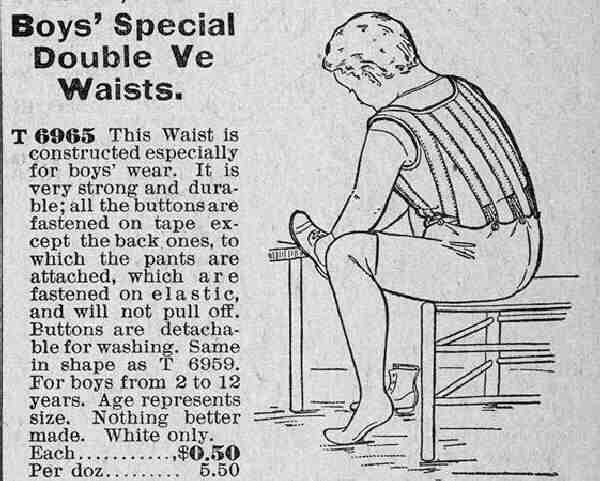Construction
Although it has provision for attaching supporters, no garters come with the garment. This is an underwaist for boys aged 2 to 12 years of age with a system of tape reinforcement straps to which waist buttons are attached so that knee pants can be buttoned on (front, sides, and back). The front and side buttons are sewn onto the tape strips in front and on the sides and are stationary. But the three back waist buttons are sewn onto elastic extensions of the tape straps so that they stretch like boys' suspenders and therefore have
greater flexibility.
Getting Dressing
The illustration shows a boy of about 12 putting on his shoes (notice that they are ankle high boots). He has already put on his long stockings and attached them to the supporters which are
also attached to the waist underneath his trousers. The knee pants are put on after the stockings and attached to the waist buttons in front, on the sides, and in back. We can't see the attachment for hose
supporters in this illustration, but undoubtedly the supporters fasten to the waist at the sides either by buttons or by safety pins and of course are worn underneath the boys' knee pants. This boy appears to
be wearing a long-sleeved undershirt or union suit with the washable sleeveless waist on top. The "double ve" consists of two triangles of reinforcement material at the sides of waist to which buttons for
trousers and garters are attached. They are mostly hidden because the boy has already put the trousers on. Illustrations like this are useful in understanding how boys dressed. We have used them for our Getting Dressed project.
Ad Copy
The Wards ad copy read, "Boys' Special Double Ve Waists" T 6965 This Waist is constructed especially for boys' wear. It is very strong and durable; all the ubttons are fastened on tape except
the back ones, to which the pants are attached, which are fastened on elastic, and will not pull off. Buttons are detachable for washing. Same in shape as T 6959. For boys from 2 to 12 years. Age represents size. Nothing better made. White only. Each $ .50. Per dozen $5.50.
Purchasing Waists
Note that these waists were sold by the dozen at a saving of 50 cents indicates that mothers might buy them in quantity for several boys in her family, insuring a good supply when the dirty ones were being laundered.
HBC

Navigate the Boys' Historical Clothing catalog/magazine pages:
[Return to the Main Wards 1900-01 waist page]
[Return to the Main American mail order 1900s page]
[Main photo/publishing page]
[Store catalogs]
[Fashion magazines]
Navigate the Boys' Historical Clothing Web Site:
[Introduction]
[Activities]
[Biographies]
[Chronology]
[Clothing styles]
[Countries]
[Bibliographies]
[Contributions]
[Essays]
[FAQs]
[Glossaries]
[Satellites]
[Tools]
[Boys' Clothing Home]
Navigate the Boys' Historical Clothing Web Site:
[Sailor hats]
[Sailor suits]
[Buster Brown suits]
[Eton suits]
[Rompers]
[Tunics]
[Smocks]
[Pinafores]
[Long stockings]
[Underwear]
Created: 9:43 PM 7/5/2006
Last updated: 9:43 PM 7/5/2006



